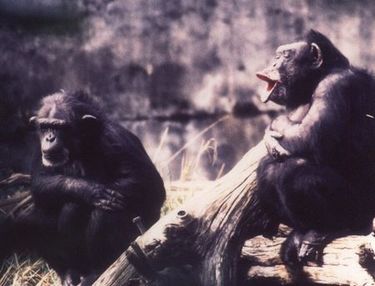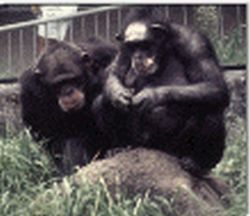Communication

Because chimpanzees are
extremely intelligent and resemble humans so closely,
scientists have wondered if they could produce human
language. Communication between nonhuman primates is
restricted to a small number of sounds that are used for
specific events or behaviors. (Recent studies suggest
there may be more flexibility in their use of sounds and
combination of sounds than previously recognized.) For
example, a chimpanzee finds a tree with ripe fruit. It
gets excited and makes grunting sounds called "food
grunts" to inform the others of the location of the
food. This type of grunt is always associated with food
and excitement because nonhuman primate communication
originates in the limbic system of the brain. The limbic
system is an area of the brain area that regulates
hormones, heart and respiration activity. Damage to the
limbic system will result in deficits in the production of
facial expressions, such as fear grins that are linked to
emotional states.
The following are some
of the more common facial expressions of chimpanzees:
|

Aggressive
|

Begging
or Frustrated
|

Excited
|
|

Moderately
Excited
|

Playful
|

Submissive
|
Chimpanzees make loud
piercing calls that carry long distances to identify the
individual. These particular vocalizations are called
"pant-hoots". If a chimpanzee hears a pant-hoot
of a stranger, it waits silently and alert to learn if
more strangers are near before proceeding on its way.
Pant-hoots may be voiced in a variety of emotional
situations: requesting the identity of another chimpanzee,
upon finding a food source, during feeding bouts, or in
times of fear or joyous times, such as reunions.
Captive Chimpanzees

Chimpanzees in zoos can
be heard pant-hooting from a long distance. However, their
visual and postural communication is more subtle. It
requires the visitor to approach the chimpanzee habitat
and watch attentively.
Some laboratory
chimpanzees and gorillas have been taught to use forms of
human communication such as ASL (American Sign Language of
the Deaf) and symbolic computer languages. These apes
learned to form and to read several hundred signs
correctly. They spontaneously invented new signs to
communicate new information. Using non-spoken human
language, they voiced wants, needs, and in one case,
emotion. This evidence suggests that structures in the
brain capable of producing rudimentary language skills
exist in the brain of non-human primates.
Captive Chimpanzees

Chimpanzees have large
complex brains and perform sophisticated behaviors. It is
important that they live in environmentally rich habitats
to stimulate mental activity and reduce boredom. In
addition, the use of "enrichment" devices and
activities, novel objects and foods, intellectually
stimulating feeding strategies (such as hiding food in
browse, hidden holes in simulated trees and other
structural objects in the habitat), keep the chimpanzees
occupied. Keepers and volunteers are constantly in search
of new enrichment ideas to add variety to the chimpanzees'
day.
Captive Chimpanzees
Chimpanzees living in
zoo enclosures are also territorial, preferring some areas
of the exhibit to others. Dominant chimpanzees may occupy
favored areas of the enclosure while those low in rank
remain at a distance. In some cases, fights over specific
areas and the right to favorite females occur. Some zoos
allow the chimpanzees free access to indoor and outdoor
exhibits to lessen aggression. Still other zoo chimpanzees
living together appear to cohabitate without any serious
problems.









